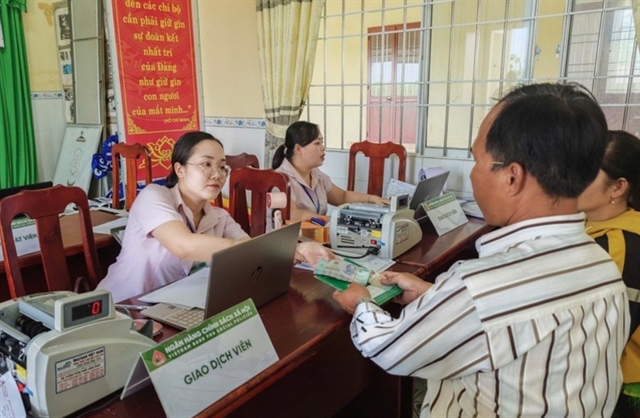 Economy
Economy

 |
| Transactions at MB. Photo courtesy of the bank |
HÀ NỘI — Credit growth of 18–20 per cent for 2025 appears achievable as banks’ outstanding loans continued to expand over the first nine months.
However, the banking sector still faces the challenge of sustaining an accommodative monetary stance and low interest rates amid growing inflationary and exchange rate pressures.
According to consolidated third-quarter data from 27 listed banks, total customer lending rose by 15 per cent compared to the end of 2024, reaching over VNĐ13.6 quadrillion.
Twenty-two banks reported loan growth above 10 per cent. BIDV, ABBank and Viet A Bank each rose by around 9 per cent, while PGBank gained 7 per cent. Saigonbank was the only one to record a decline, down 6 per cent.
State-owned banks continued to lead in capital supply. BIDV’s outstanding loans surpassed VNĐ2.23 quadrillion, up 8.8 per cent, equivalent to VNĐ180 trillion added to the economy. VietinBank reached nearly VNĐ1.99 quadrillion, up 15.6 per cent, and Vietcombank grew by 12.5 per cent to VNĐ1.63 quadrillion.
Among joint stock commercial banks, MB recorded nearly VNĐ931.5 trillion in outstanding loans, up almost 20 per cent since the start of the year.
MB General Director Phạm Như Ánh said the bank aimed for 25–30 per cent growth this year, driven by the retail and SME segments. VPBank’s lending rose by 29.4 per cent to VNĐ896.4 trillion, while Techcombank, ACB, SHB and Sacombank all posted double-digit increases, with Techcombank up 21.4 per cent and SHB 17 per cent. NCB led the sector with 33 per cent growth.
Rồng Việt Securities Company (VDSC) reported overall credit growth of 14.5 per cent by the third quarter – the highest in five years.
It noted a narrowing divergence in growth rates among banks as many approached their credit ceilings and shifted focus to profitability. Credit market share has become more balanced between State-owned and major private lenders, while medium- and long-term loans have grown faster than short-term ones, signalling renewed investment and production demand.
Policy balance
Economist Nguyễn Xuân Thành from Fulbright School of Public Policy and Management said to meet the 2025 GDP target of at least 8 per cent, credit growth of about 19–20 per cent would be needed. This would require the State Bank of Việt Nam (SBV) to maintain a supportive policy stance and direct credit towards productive investment.
However, rising inflation and exchange rate volatility posed major challenges, likely to persist into 2026. Thành identified three factors driving upward pressure on market interest rates: higher inflation expectations, đồng depreciation and credit growth exceeding money supply expansion.
Although inflation remained moderate this year thanks to lower oil prices, it was expected to accelerate next year.
Thành said: “The đồng has already weakened by 3.8 per cent against the US dollar and 13 per cent against the euro in the first ten months and by an average of 5.1 per cent against the currencies of Việt Nam’s main trading partners.”
The SBV faced the dual task of keeping interest rates low to support growth while containing inflation and stabilising the currency.
Thành added: “Compared with major economies, Việt Nam’s inflation is the highest, yet our interest rates are the lowest - even lower than China’s. Maintaining such low rates comes at the cost of a weaker đồng.”
Earlier, at the Việt Nam Investment Forum 2026, Dr Nguyễn Tú Anh, Director of Policy Research at VinUni University, said capital remained a crucial growth driver alongside labour, science, institutions and the environment.
If Việt Nam targets GDP growth of 10 per cent by 2030 with inflation at 3 per cent, nominal growth would be around 13 per cent, meaning credit must expand roughly three percentage points faster.
The country’s total credit volume would need to double over the next five years. — VNS



